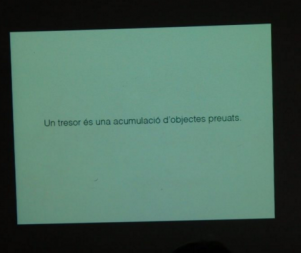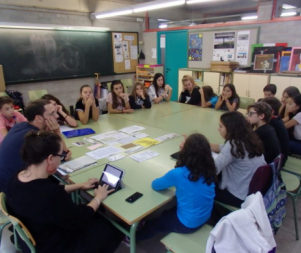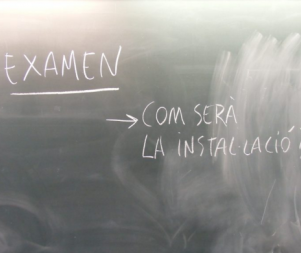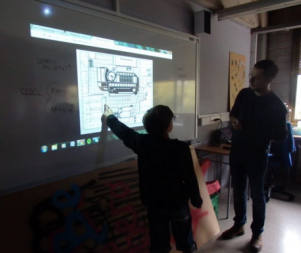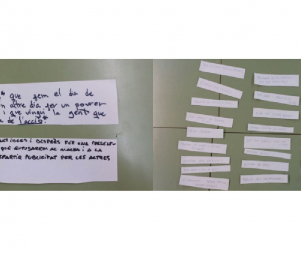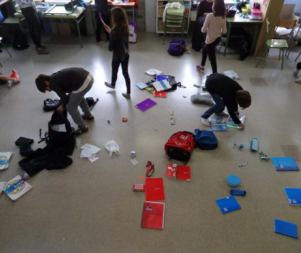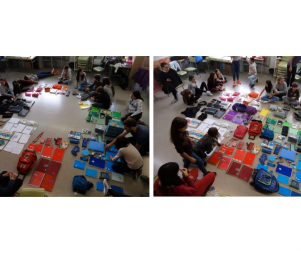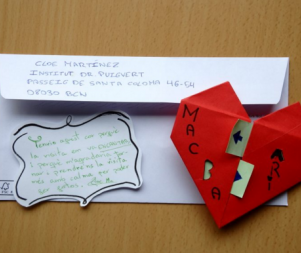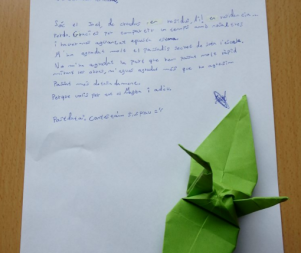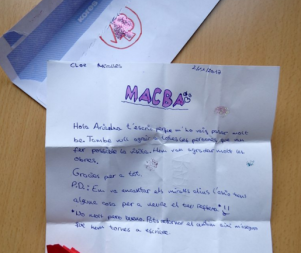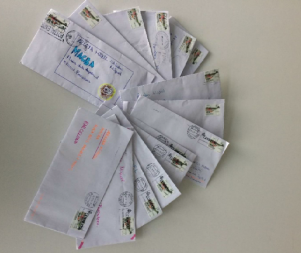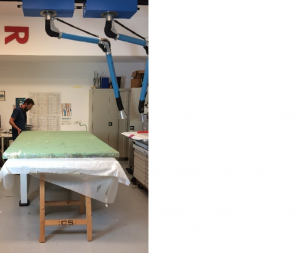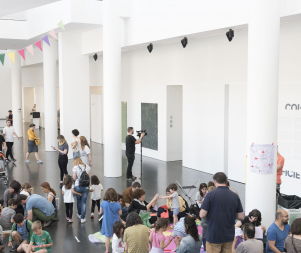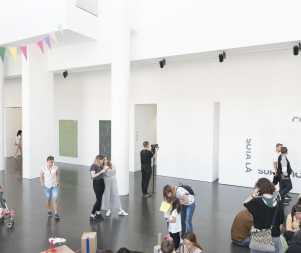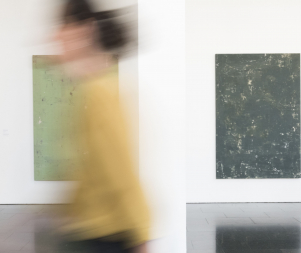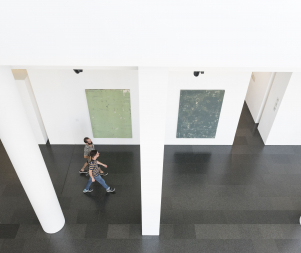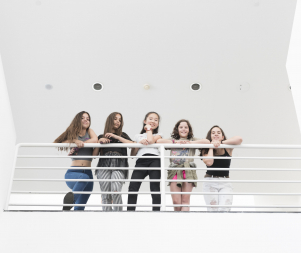- 14th EDITION 2022 / 2023
- 13th EDITION 2021 / 2022
- 12th EDITION 2020 / 2021
- 11th EDITION 2019 / 2020
- 10th EDITION 2018 / 2019
- 9th EDITION 2017 / 2018
- 8th EDITION 2016 / 2017
- 7th EDITION 2015 / 2016
- 6th EDITION 2014 / 2015
- 5th EDITION 2013 / 2014
- 4th EDITION 2012 / 2013
- 3rd EDITION 2011 / 2012
- 2nd EDITION 2010 / 2011
- 1st EDITION 2009 / 2010
Enric Farrés Duran IN RESiDENCE at the School Doctor Puigvert
RESIDENT ARTIST
Introduction
We found his artistic practice interesting due to the relationships he creates between objects, the performative dimension he gives to documents, because he is a narrator of stories in which reality and fiction merge, and his poetic approach to everyday life.
Enric Farrés Duran invites us to find unusual coincidences, unexpected connections, to explore the other side of things we know in order to discover new meanings in which nothing is what it seems. The artist suggests constructions and fictions that take the form of routes, installations, literature and collections. Collective exercises in first-hand experience to stimulate ideas revolving around play, surprise, discovery, chance, as attempts to subjectively reorganise the world that surrounds.
CALENDAR OF THE SESSIONS
Presentation
October 5: brief introduction to Enric Farrés, who asks the pupils to give him a guided tour of the school.
October 19: Enric presents several of his own projects.
Soundings. Introduction to and experimentation with a creative process
October 26: first visit to MACBA: exploration of the museum’s “entrails”.
November 2: letters to Ariadna Miquel (Education coordinator) and Pablo Martínez (head of Programmes).
November 9 and 16: classroom activity: classification of personal belongings.
Development of the creative process
November 23: first brainstorm for the final work.
November 30: session without the artist. Visit to the classroom of pupils who took part in the project.
December 14: selection of ideas.
January 11: debate and vote on ideas.
January 18: definition of the ideas selected.
January 25: development of ideas. Individual creation of triptychs.
Pre-production
February 1: examination and presentation of projects.
February 15: second visit to MACBA: the Collection. Intervention in the room notes based on Ignasi Aballí’s work Gran error. Interaction with spectators following the action.
February 22: session without the artist, led by Mercè Gaja. We show the group the documentary Rere el MACBA. Retrat d’un museu [Behind MACBA: Portrait of a Museum], made by pupils at Moisès Broggi secondary school.
March 2: session in the school hall: development of ideas.
March 8: the teacher Pau Esqué joins the project. Development of ideas.
March 15: preparation of the meeting at MACBA with Ferran Barenblit (director) and Pablo Martínez (head of Programmes) to present the work.
March 21: presentation of the project to teachers.
March 22: third visit to MACBA: the pupils meet Ferran Barenblit, Pablo Martínez and Ariadna Miquel. Conversations and negotiations to show the work at MACBA.
Production
April 5: activations/list of actions to perform as part of the work.
April 12: establishment of the production calendar.
April 20: the painter Gina Giménez is invited to the classroom. Production of the canvases. Individual experimentation with the technique to be used to create the pictures.
May 3: visit to Hangar Centre of Visual Art Production and Research. Production of the audio device.
May 10: organisation, calendar, title and preparation of the poster.
May 17: recording of sound actions.
May 24: rehearsal at MACBA and meeting with the communication department to talk about the strategy for promoting the action on the social media. The work is also brought to the museum: the insurance certificate and in/out note are made out to guarantee its security while in the MACBA storage and exhibition rooms. When the paintings arrive, problems are detected with regard to the attachment of the canvas, and the restoration department is requested to repair them in their workshop.
May 25: Mercè Gaja and Ariadna Miquel observe a final rehearsal of the actions in the school library.
Action and presentation of the work
May 26: presentation of No només és això to spectators at the museum.
June 8: presentation of No només és això to teachers and parents at the school. Close of project.
FROM THE CLASS ROOM TO THE MUSEUM AND FROM THE MUSEUM TO THE CLASSROOM
Over the course of the project, the group made a total of three visits to the MACBA, not counting the two rehearsal days and the performance of the actions at the museum. Here, the flexibility of the teachers and the museum management team were crucial, as it took an hour to get from the school to MACBA, meaning that the lesson times for this optional subject had to be extended. Many of the pupils visited MACBA for the first time.
The meeting at which the pupils presented their project to the MACBA director, Ferran Barenblit, and the head of Programmes, Pablo Martínez, was a crucial point in the project and in the empowerment of the group. This was the most thought-provoking moment in the preparation and presentation of the project, as they had to argue its strong points and justify its presence in the museum. This process served to make the work closer to their hearts.
Initially, the work was designed to be a space for interaction between the public, the artists and the architecture of the museum. This was among the subjects discussed, as Ferran Barenblit and Pablo Martínez intervened with a series of questions that led to a very interesting debate on issues such as spectators’ image rights and the points of references of the work performed. During the question and answer session, Ferran Barenblit also suggested that the interaction should be direct, that the artists should mix with museum visitors rather via a device, as proposed by the pupils, in which the interior and exterior of the work are clearly separated and in which the pupils carry out a series of interventions concealed from museum visitors. At all times, the pupils maintained a convincing, persuasive dialogue with representatives from the institution, and this made it clear that preparing and staging the meeting had made them aware of how firmly consolidated the idea of the “work” they wanted to create had become.
At the meeting, Enric Farrés made a telling comment on the maturity of the, noting that their age had little influence in the creative process: “Thinking about the experience, I feel that the pupils’ age is irrelevant. I mean, one of the main goals was to develop a professional project in its entirety (production, mediation, dissemination), and the fact that they were twelve years old is irrelevant and that there was no need for any translation and/or adaptation processes. This was an experimental starting point – at least for me – that I found absolutely fine, because the fact that they had no previous experience meant there were no expectations and, consequently, any and all results were welcome”. After this meeting, working on the finer points and changes that arose from the discussion with Ferran Barenblit, the final process of producing the work began, as described below.
CONCEPT AND PRODUCTION
Concept and production form part of a single learning process. Accordingly, then, rather than ask ourselves the question “what do we do?” or “what shall we do?”, we ask “what are we doing?”. Perhaps this reformulation throws doubt on something found in the study programme at some secondary schools: the idea of creating something, of making something, when the thing is the process, to be doing it.
The artist suggested the production process as a moment when it is key to involve different stakeholders in order to successfully perform the task proposed. This throws light, not only on his methodology, but also the idea that the contemporary artist is not always an artisan, that is to say, he or she does not always make the work with his or her own hands. At this point, it is useful to learn how Enric Farrés will work with the pupils. Although he is, without doubt, a guide and an adult who will work with them in the creative process, he will also become, above all, an experienced member of an art group in which there is no hierarchical relationship.
The artist Regina Giménez also contributed to the creative process, on April 20 visiting the classroom to propose a series of experiments for the pupils, with TVs, varnish and oil. Encouragement for the process came next from Pense, head of production at Hangar. On May 3, we visited Hangar to see an art production centre and to learn about Pense’s technical proposal to install two Bluetooth speakers behind the TV sets to transmit all the sounds of the pupils sent via two mobile phones.
The cooperation of the entire MACBA team was also key, as several museum departments were involved: production, registration, restoration, communication, collection and audiovisual and education, as well as the management team.

